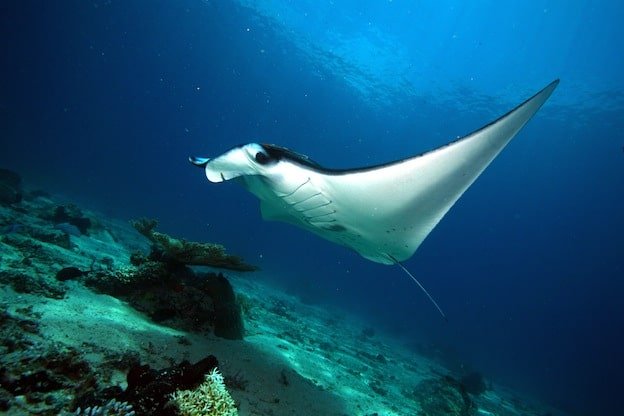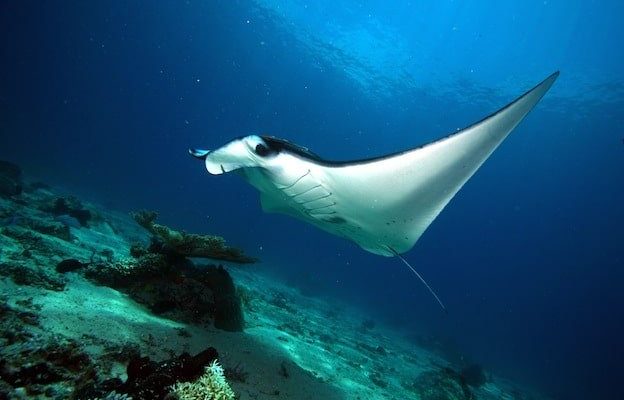
Manta rays primarily inhabit tropical and subtropical oceans, but their range extends beyond just the open seas. They’re not strictly ocean-dwelling creatures—some species even appear in brackish waters, which are a blend of fresh and saltwater. Imagine them as the nomads of the sea, constantly on the move in search of food and warmer waters. Let’s explore where these magnificent rays can be found, the habitats they thrive in, and what makes those areas suitable for them.
1. The Oceans: Manta Rays’ Primary Habitat
Manta rays are primarily found in the world’s oceans, where they enjoy a variety of environments. You can typically spot them in *tropical and subtropical regions*, where the water is warm, clear, and rich in nutrients. They prefer areas near coral reefs, as these ecosystems are abundant in the plankton and small fish that make up their diet.
You might be wondering how these creatures navigate the vast ocean. Manta rays are known to migrate across large distances. For instance, some populations in the Pacific Ocean travel hundreds of miles to follow seasonal blooms of plankton. It’s kind of like traveling for a buffet feast—they go where the food is best, demonstrating their adaptability and resourcefulness.
Most often, you’ll find manta rays near the surface of the water, where they can easily feed. Here, they engage in a behavior called *filter feeding*, where they swim with their mouths open, filtering out tiny organisms. It’s a fascinating sight that showcases their unique feeding strategy and highlights the importance of healthy marine ecosystems.
2. Coastal Areas: Manta Rays’ Feeding Grounds
While open oceans are vital to manta rays, they often frequent *coastal areas* as well, especially during feeding times. Coastal regions are bustling hubs of marine life, and this abundance attracts manta rays to shallow waters. Areas like the *Great Barrier Reef* in Australia or the *Galapagos Islands* are prime examples where these rays congregate.
During certain times of the year, coastal areas experience upwellings, where nutrient-rich water rises from the ocean depths to the surface. These conditions are perfect for plankton blooms, making these waters an ideal buffet for manta rays. For instance, in places like Ecuador, mantas gather in large numbers during upwelling seasons, creating a spectacular natural event that draws divers and marine enthusiasts from around the globe.
Coastal habitats also provide protection from stronger ocean currents, allowing manta rays to comfortably maneuver and feed. With their wide wingspans (which can reach up to 29 feet!), these creatures can easily glide through the waters close to the shore, enjoying the benefits of abundant food while remaining safe.
3. Temperate Waters: A Surprising Discovery
You might assume that manta rays only thrive in warm waters, but they have also been spotted in *temperate waters*. These areas are typically cooler and can be less diverse than tropical regions. However, certain populations of manta rays adapt to seasonal changes and find themselves in these environments during different times of the year.
For example, manta rays can be found off the coasts of California and South Africa, where the waters are cooler. They often venture here to join large schools of plankton and small fish, taking advantage of the abundant food sources during specific seasons. Here’s the thing—while they might not spend as much time in these cooler waters, their ability to adapt showcases their resilience.
Sightings in these regions often surprise marine researchers, as understanding their behavior in temperate waters can offer valuable insights into their migratory patterns and feeding habits. It opens a window to studying how these majestic creatures respond to changes in their environment.
4. Brackish Waters: An Unusual Habitat
It’s not just oceans that support manta rays. They’ve also been spotted in *brackish waters*, which are a mix of saltwater and freshwater. These environments are typically found in estuaries and coastal lagoons, where freshwater rivers meet the ocean. You might think, “Why would a sea creature go there?”
Manta rays often enter brackish waters to feed on the abundant plankton that can thrive in these nutrient-rich environments. For example, certain lagoons in coastal regions provide ideal conditions for feeding, as waters become rich in nutrients from both river runoff and oceanic currents.
Typically, these visits are temporary, with rays spending just enough time to feast before returning to their preferred habitats. This adaptability is a testament to their survival skills, allowing them to exploit various environments when food is plentiful.
5. Coral Reefs: Manta Rays’ Underwater Sanctuaries
Coral reefs are among the most vibrant ecosystems on the planet, and they provide crucial habitats for manta rays. These underwater gardens are not only beautiful but are teeming with life, making them perfect for feeding and gathering. Manta rays often congregate around *cleaning stations*, where smaller fish help remove parasites and dead skin from their bodies.
Visiting these stations can be thought of as a spa day for manta rays. They approach these spots and allow smaller fish to do their work, leaving them feeling refreshed and clean. It’s a mutualistic relationship that benefits both parties—manta rays get groomed, and the smaller fish get a free meal.
Coral reefs also serve as breeding and nursery grounds for various marine species, further supporting the healthy ecosystem that manta rays rely on. Without vibrant and healthy coral reef systems, the entire marine food web becomes compromised, highlighting the importance of protecting these beautiful underwater habitats.
6. The Importance of Migration
One of the most fascinating aspects of manta rays is their migratory behavior. These creatures are often found in different locations depending on the time of year, following the food supply and changes in water temperature. Understanding their migration patterns is crucial for conservation efforts.
For instance, some manta rays migrate between the Indian and Pacific Oceans, following the seasonal shifts of plankton blooms. These long-distance travels can span thousands of miles, showcasing their impressive navigation skills. It’s like they have a built-in GPS guiding them toward the best feeding opportunities.
Unfortunately, these migrations also make manta rays vulnerable to threats like overfishing and habitat destruction. Protecting their migratory routes and habitats is essential for ensuring the survival of these magnificent creatures, as their journeys are vital for their feeding, breeding, and overall health.
7. Conservation Efforts and Challenges
Given their crucial role in maintaining healthy marine ecosystems, conservation efforts for manta rays are increasingly important. Their populations face threats from habitat degradation, climate change, and illegal fishing practices. Organizations and researchers are working together to create awareness and protect these incredible animals.
Many countries have established marine protected areas (MPAs) to help safeguard manta rays and their habitats. These MPAs are crucial for giving manta rays safe spaces to feed, breed, and migrate without the pressures of fishing or pollution. Additionally, educating local communities about the importance of these creatures fosters a culture of conservation.
Despite these efforts, challenges remain. Climate change is altering ocean temperatures and disrupting food sources, making it harder for manta rays to survive. Here’s the thing: the more we learn about these creatures and their habitats, the better equipped we are to develop strategies to protect them. It’s a collective effort that requires global participation and understanding.
In closing, the world of manta rays is as fascinating as it is complex. From their homes in the ocean and coastal areas to their surprising visits to brackish waters, these majestic creatures need healthy habitats to thrive. By understanding where they are found and the challenges they face, we can contribute to their conservation and ensure they continue to grace our oceans for generations to come. Let’s appreciate these gentle giants and work together to protect their underwater world.

